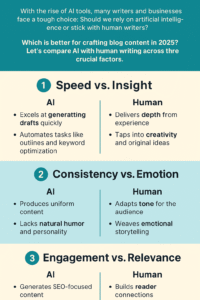✨ A True Story: The $10K Blog Post Test
In early 2025, a freelance content strategist named Lisa took on a challenge: write two blog posts for a client in the productivity software niche. One would be written entirely by her, and the other by an AI writing assistant. Both articles were optimized for SEO, promoted equally, and tracked with detailed analytics.
After 30 days, the results were surprising:
- The AI-written post ranked faster and generated 20% more clicks.
- The human-written post had 3x the average time-on-page and got 4 backlink requests.
The client asked, “Which one do we keep doing?” Lisa replied, “Both.”
This real-world test reflects a broader truth: AI and human writers serve different roles in modern content strategy. In this article, we’ll compare them across productivity, quality, authenticity, SEO, and psychology—and end with a clear 5-step action plan you can apply today.

🌐 The Rise of AI in Content Creation
Pros of AI Writing Tools (2025)
- Speed: Tools like ChatGPT, Jasper, and Claude can create long-form drafts in minutes.
- Volume: AI can produce dozens of articles at scale.
- SEO integration: AI tools suggest keywords, headings, and meta tags.
But There Are Tradeoffs…
- Lack of context: AI can’t access real emotions or past experiences.
- Over-optimization: Content sometimes reads robotic or overstuffed.
- Blind spots: AI may confidently make errors or misrepresent facts.
AI writing is a productivity powerhouse, but creativity and insight still come from real people.
🎓 The Psychology of Great Content: 3 Theories That Explain What Works
1. Dual-Process Theory (Kahneman, 2011)
This theory divides thinking into:
- System 1 (fast, intuitive, emotional)
- System 2 (slow, analytical, reasoned)
AI often nails System 2 tasks: data-driven, logical, structured writing. But human writers excel at System 1: evoking emotion, empathy, and imagination.
“The best content taps into both systems.”
2. Self-Determination Theory (Deci & Ryan, 1985)
Humans are motivated by:
- Autonomy (control)
- Competence (mastery)
- Relatedness (connection)
Blog posts that feel authentic and human-driven satisfy these needs. That’s why founder stories, personal lessons, and transparency-driven writing build trust—something AI alone cannot replicate.
3. Elaboration Likelihood Model (Petty & Cacioppo, 1986)
There are two paths to persuasion:
- Central route: logical reasoning and facts
- Peripheral route: emotion, tone, credibility
AI dominates the central route with structured arguments. But the peripheral route (storytelling, humor, vulnerability) remains a human strength.
📊 SEO: Who Wins the Google Game?
Where AI Shines:
- Optimizing titles, meta descriptions, schema
- Generating topic clusters and internal link suggestions
- Creating scalable content libraries (FAQs, listicles, glossaries)
Where Humans Still Win:
- Writing for search intent over keywords
- Generating backlinks through authentic value
- Creating content so good AI recommends it
SEO in 2025 is about helpfulness and quality. Google doesn’t care if a human or AI wrote it—as long as it delivers value.
🤝 AI + Human: The Hybrid Writing Model That Wins
The future isn’t one or the other. It’s both.
How Smart Teams Combine Them:
- AI does: Outline generation, first drafts, SEO structuring
- Humans do: Editing, fact-checking, emotional resonance
Benefits:
- Cut writing time by 50%+
- Maintain brand voice and depth
- Produce more with less burnout
If AI is the engine, humans are the steering wheel.
📆 Action Plan: 5 Steps to Smarter Blog Content in 2025
1. Pick the Right Tool
Choose a GPT-powered writing assistant like Jasper, Claude, or Notion AI. Use it for ideation, structuring, and speed.
2. Define Human-Only Zones
Always write human-led:
- Introductions
- Personal stories
- CTAs
- Controversial opinions or ethical takes
3. Edit for Realness
Use AI as your assistant, not your ghostwriter. Always:
- Fact-check stats
- Replace generic sentences with specifics
- Add humor, vulnerability, or style
4. Train AI on Your Voice
Use prompt engineering or custom GPTs to write like you. Feed previous writing samples and tone guides.
5. Measure What Matters
Don’t obsess over word count or publishing velocity. Track:
- Time on page
- Shares and backlinks
- Leads or conversions from content
📝 Summary: So, Who’s Better?
AI is fast, scalable, and SEO-smart. Humans are emotional, creative, and authentic. The real power is in the partnership.
If you’re a solopreneur or content creator in 2025, your advantage isn’t being better than AI. It’s knowing when to let AI assist—and when to bring your full, human voice to the page.
The future of writing? It’s not machine vs. man. It’s machine + human, working together to create content that performs and connects.
✅ Your Next Step:
Pick one AI tool. Automate one task. Save your first hour.
Ready to take the first step? Grab our free AI Toolstack PDF or explore our “Prompt Pack for Creators” to get started today.